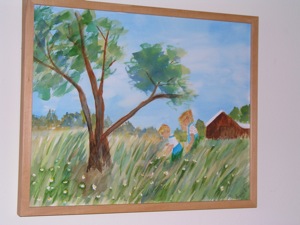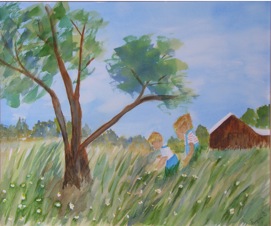Photographing Pictorial Artworks
I recently had a project to take pictures of a series of my mother’s paintings in her home. The paintings were hanging on various walls and needed to be photographed in-place. I had to move quickly, so there was no time for tripods and fancy lights. There was a need for flash, though, as there was insufficient lighting in some of the hallways. Many of the works were behind glass. If I had an optically perfect lens which had no trace of barrel or pincushion distortion, and if I had the ability to exactly center the camera in front of the photo, I could have achieved a rectangular final image, but would have had a nasty hot spot from the flash reflecting off the glass or the surface of the painting, or I might have had a reflection of myself and the camera in the glass. In reality, I didn’t have a perfect lens and couldn’t get exactly centered in front of the art work.
Knowing that there was a tool in Photoshop that could help me, I intentionally shot these photos off-axis to avoid the reflections of me and the camera as well as the hot spot that would otherwise be created with the flash. Of course, that also meant that the pictures would be skewed with an unwanted perspective. The helpful tool in Photoshop is the Crop tool, but it was used in a somewhat atypical way.
The image on the left is my original image from the camera. Note the desirable absence of a hot spot from a flash. Note also the undesirable narrowing of the view of the picture from left to right, and also the non-vertical left-edge of the picture. All of these problems were fixable. I brought the image into Photoshop and used the Crop tool to drag out a rectangle approximating the painting. I didn’t have to be very precise in this step. The resulting crop-selection rectangle was adorned with “handles” on the sides and in the corners. My next step was to simply move the four corners, one at a time, to the corresponding corners in the painting, distorting the crop-selection “rectangle” into an irregular quadrilateral. My final step was to issue the “Crop” command from the menu and Photoshop produced a perfect rectangle, effectively correcting for the induced perspective, as shown in the image on the right.
This use of the Crop tool is actually extremely helpful in correcting perspective distortion in architectural images, and can be used for artistic purposes to introduce perspective distortions. Our use of it was fairly simple and journalistic, and it allowed us to take pictures quickly and imperfectly (while avoiding the reflections and flash hot spot) and correct for the distortions after the fact.

Tip of the Week
2007.03.26


